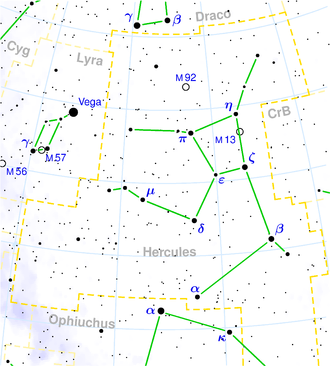NGC 6575
| Galaxy NGC 6575 |
|
|---|---|
|
|
|
| AladinLite | |
| Constellation | Hercules |
|
Position equinox : J2000.0 , epoch : J2000.0 |
|
| Right ascension | 18 h 10 m 57.49 s |
| declination | + 31 ° 06 ′ 58.3 ″ |
| Appearance | |
| Morphological type | E3 |
| Brightness (visual) | 13.0 likes |
| Brightness (B-band) | 14.0 mag |
| Angular expansion | 1.8 ′ × 1.3 ′ |
| Position angle | 65 ° |
| Surface brightness | 13.0 mag / arcmin² |
| Physical data | |
| Redshift | 0.023323 ± 0.000050 |
| Radial velocity | 6992 ± 15 km / s |
|
Stroke distance v rad / H 0 |
(321 ± 23) x 10 6 ly (98.4 ± 6.9) Mpc |
| history | |
| discovery | Truman Safford |
| Discovery date | June 7, 1866 |
| Catalog names | |
| NGC 6575 • UGC 11138 • PGC 61506 • CGCG 172-009 • MCG + 05-43-006 • 2MASX J18105749 + 3106584 • WISEA J181057.47 + 310658.2 • NVSS J181057 + 310656 • KPG 530B | |
NGC 6575 is a 13.0 likes bright elliptical galaxy from the Hubble type E3 in the constellation Hercules at the northern sky . It is an estimated 321 million light years from the Milky Way and about 170,000 light years in diameter. Together with IC 1277 , it forms the isolated pair of galaxies KPG 530 .
The type I supernova SN 2002cu was observed here.
The object was discovered on June 7, 1866 by Truman Henry Safford .
Web links
- NGC 6575. SIMBAD , accessed September 19, 2019 .
- NGC 6575. DSO Browser, accessed September 19, 2016 .
- Auke Slotegraaf : NGC 6575. Deep Sky Observer's Companion, accessed on September 19, 2016 (English).
- Aladin Lite: NGC 6575
